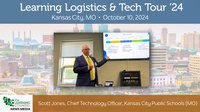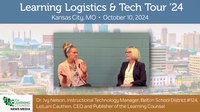With experts projecting that five million K-12 students (most of them high schoolers) will enroll in an online course by 2016, there’s no doubt that the blended learning model is here to stay. But as they do, when any ed tech tool or approach makes the transition from novelty item to classroom staple, educators around the country are asking the key question: “Does blended learning give better outcomes than traditional classes?”
According to a recent research report from Arizona State University’s Mary Lou Fulton Teachers College, the answer is yes. The paper, written by Dr. Deborah Stirling; Dr. Gary Bitter; and Paul Skiera, M.Ed, reviews “the most effective and research-based methods of instructional models, instructional strategies, and domain-specific design features.” Basing their conclusions on major reviews of research conducted over the past 10 years, the authors found that “blended learning significantly outperforms face-to-face classroom instruction.”
But just proclaiming that you’re blending doesn’t do the trick, they wrote. “The pedagogical pattern used with online learning makes the difference. For instance, when students experience blended learning with both collaborative learning activities and teacher-directed instruction, the blended learning students significantly outperform students only engaged in active self-study.” Here are three ways that blended learning can turbocharge teaching and learning.
Customizing the Learning Experience
Sterling and her colleagues found that personalized online learning can, indeed, improve academic performance among students all over the academic spectrum. As they wrote, “Online learning systems that determine students’ level of understanding, customize the material for them, provide an interactive set of instructional activities with feedback to students, produce detailed reports about students’ progress, and offer teachers who supplement instruction by explaining concepts and facilitating student discussion yield higher results for low-achieving students on state assessments.”
The authors also stressed the effectiveness of online learning platforms that can adapt to students who might need to move faster than the rest of the class. “Research indicates that customizations based on evidence from student work leads to improved learning outcomes,” they wrote.
Adapting to Students’ Needs
According to Sterling and her team, research on adaptive learning “has determined that it has the largest effect size of any instructional model. Moreover, studies have shown that adaptive learning systems are more efficient and more effective in achieving student outcomes relative to traditional methods.”
To create the atmosphere in which teachers can best adapt their lessons to student’s needs, the authors concluded that the best-blended classrooms offer the following:
1) A fast-paced, convenient, and flexible course;
2) A thorough curriculum;
3) Practical examples; and
4) Teachers who are responsive to student questions.
Embedding Formative Assessment
For many educators, assessment is a necessary evil. But when it comes to improving student achievement, the right type of assessment can actually help students learn better. As the authors wrote, “Multiple studies have found that formative assessment has more impact on student learning and achievement than any other researched educational innovation.”
The researchers then went on to detail the essential elements of formative assessment:
1) Identification by teachers and students of learning goals, intentions or outcomes, and criteria for achievement;
2) Conversations (with feedback) between teachers and students that build on what is known and what is to be learned; and
3) Active involvement of students in their own learning, and teachers responding to identified learning needs and strengths by modifying and/or adapting teaching strategies, materials, and approaches. Students and teachers can work through these steps with no technology at all, but, as the writers pointed out, “Online assessments afford students the benefits of being able to take the assessment at any time, being able to take it multiple times, and receiving instant feedback.”
Online assessments can be especially helpful to accomplished students who don’t respond well to the pressurized atmosphere of high-stakes tests. As Sterling and company put it, “Studies have also found a reduction in anxiety when students take formative assessments before the summative assessment.”
Putting Theory Into Practice
For practical application of all of the concepts laid out above, the researchers looked to online curriculum and e-learning provider Odysseyware.
The platform provides a Teacher Authoring Tool that empowers educators to customize their coursework by creating anything from a single lesson, project, quiz, or test to an entire course. Featuring a WYSIWYG interface and drag- and-drop functionality, the Teacher Authoring Tool allows educators to bring their lessons to life with Web 2.0 tools, videos, animations, text, and learning games and activities.
When it comes to bringing the adaptive instructional model to life in the classroom, Odysseyware uses Credit Recovery Mode (CRx), an adaptive engine that provides students with prescriptive learning paths based on assessed content mastery in higher grades. Pretests before each instructional unit determine whether students can skip a unit or whether it should be added to a student’s instructional path.
To deliver formative assessments, Odysseyware uses an assessment engine called Flex Assessment to place students into a course and then deliver formative assessments throughout the program to keep the teacher up to date about the instructional tools that are appropriate for a given student, continuously guiding the adaptive instructional path.
As Sterling and her co-authors wrote, “The instructional strategies incorporated in Odysseyware courses have consistently demonstrated the largest effect sizes of any instructional strategy, especially when implemented as blended learning. The effectiveness has been demonstrated in a wide range of content areas, but the strongest evidence is in math and reading.”
Research has also investigated the range of ways in which digital learning systems can be implemented, and the benefits of using a system as a way to leverage teacher time and improve learning. The research also emphasizes the importance of “fidelity of implementation” and the need to give students access to peers, teachers, and technology, if students are to get the full benefit of blended learning.
The researchers concluded, “careful implementation planning, professional development, and adequate resource planning are critical.”











